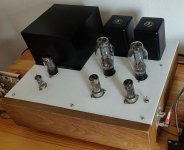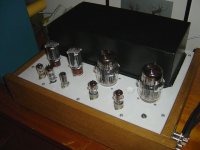This may be a square (obsolete) question:
If I was to build something into an non conductive case (acryl, wood, coriander, glass, or even marble), what consequence would this have on the grounding schemes?
If I was to build something into an non conductive case (acryl, wood, coriander, glass, or even marble), what consequence would this have on the grounding schemes?
RANE notes to rescue 😉 Grounding and Shielding Audio Devices
Your circuitry and wiring is subject to stray electromagnetic fields without proper chassis. This might or might not be a problem depending on your environment. All kinds of electronics and RF communication are abundant nowadays so I'd suspect the performance suffer not having a chassis as protection from external noise.
Grounding scheme: you would just insert a cable to replace ground path that would normally be through the chassis.
Your circuitry and wiring is subject to stray electromagnetic fields without proper chassis. This might or might not be a problem depending on your environment. All kinds of electronics and RF communication are abundant nowadays so I'd suspect the performance suffer not having a chassis as protection from external noise.
Grounding scheme: you would just insert a cable to replace ground path that would normally be through the chassis.
Last edited:
If you were intent on this you could try constructing a sort of Faraday cage out of copper clad PCB material following the model of Tom Evans' " Groove" phono preamp.
No consequences.
I always use non-conductive chassis. Wood around and 6mm Teflon or wood for top plate.
PSU is on one side, the signal part on the other. RCA input connectors are on the side of the signal part.
I use a ground-bus. It is usually 3 mm copper wire from C1 in the PSU to RCA input connectors, neatly arranged. Each stage has its common point on the ground bus; PSU on one point, input/driver stage on secound and output stage on third point.
I've never had any problems with hum or so ...
I always use non-conductive chassis. Wood around and 6mm Teflon or wood for top plate.
PSU is on one side, the signal part on the other. RCA input connectors are on the side of the signal part.
I use a ground-bus. It is usually 3 mm copper wire from C1 in the PSU to RCA input connectors, neatly arranged. Each stage has its common point on the ground bus; PSU on one point, input/driver stage on secound and output stage on third point.
I've never had any problems with hum or so ...
Attachments
Use a metal sub-chassis perhaps?This may be a square (obsolete) question:
If I was to build something into an non conductive case (acryl, wood, coriander, glass, or even marble), what consequence would this have on the grounding schemes?
In order to effectively eliminate any hum or noise issues inside a non-metalic cabinet, it's always good to use some form of shielding internally.
Lining the case with at least tinfoil or metal flashing is worth the effort, which is connected electrically with the circuit ground.
Sensitive, or high-impedance circuits benefit from such shielding.
It's just good design sense.
Lining the case with at least tinfoil or metal flashing is worth the effort, which is connected electrically with the circuit ground.
Sensitive, or high-impedance circuits benefit from such shielding.
It's just good design sense.
The op has not stated whether he is concerned about safety ground of mains powered equipment or signal grounds and elimination of noise from hum & emi.
One is an inconvenience; the other a matter of life & death!
One is an inconvenience; the other a matter of life & death!
The op has not stated whether he is concerned about safety ground of mains powered equipment or signal grounds and elimination of noise from hum & emi.
One is an inconvenience; the other a matter of life & death!
I didn‘t for 2 reasons:
- grounding stuff isn‘t really understood by (OP) [emoji6]
- if the chassis isn‘t conductive, life and death will be an issue inside it at best/worst...
What made me ask was firsthand a product-line I am somewhat fascinated of: the DNM-amps ( https://www.6moons.com/audioreviews/dnm/hero1.jpg )
Last edited:
6mm Teflon or wood for top plate.
RajkoM,
Cool stuff here.
How do you drill the Teflon?
The transformer (with mains cabling) is housed in a separate enclosure.
This may be a metal box with a safety earth or it may be double insulated and meet the required standards for this.
The amplifier is supplied from the power supply box through a cable and shouldn't need a safety earth, though it may well become connected to safety earth through the ground wires of connected equipment (cd players and such).
Sensitive equipment such as preamplifiers are generally in a metal enclosure to keep out interference; a power amp is less of an issue.
This may be a metal box with a safety earth or it may be double insulated and meet the required standards for this.
The amplifier is supplied from the power supply box through a cable and shouldn't need a safety earth, though it may well become connected to safety earth through the ground wires of connected equipment (cd players and such).
Sensitive equipment such as preamplifiers are generally in a metal enclosure to keep out interference; a power amp is less of an issue.
RajkoM,
Cool stuff here.
How do you drill the Teflon?
Circular saws for drilling machine for wood and hard plastic.
This may be a metal box with a safety earth
May I ask You if You test Your GFI's regularly ? Last week I was doing some wiring for garden lights and found out my outside garage GFI was broken.
Test button didn't respond nor a 100W lamp connected between live and ground.
So, a safety earth is not always a safety earth...
It's not the earth wiring, since it was replaced and works now.
House wiring -- including ground fault devices -- would be protected by a fuse or breaker in the panel.
Breakers are present but if the GFI doesn't work and there is a fault You get zapped.House wiring -- including ground fault devices
So, a safety earth is not always a safety earth...
It's not the earth wiring, since it was replaced and works now.
A safety earth is always a safety earth provided it is in good order.
A GFI or RCD is an added layer of protection.
Live to earthed chassis - earth may save your life.
Live to unearthed chassis - poof!
I have found 3M CN-3190 SHEET (available in the UK from Farnell) to be very successful in shielding enclosures on the inside. It is a bit pricing but very good.
I have used it on several projects - most recently to line the steel case of a Radford Distortion Measurement set - all the surfaces including the internal partitions - and it dropped the noise measured considerably.
It is fundamentally an EMI shielding made from Nickel on Copper Plated Polyester, is self adhesive and the glue that it uses is also conductive so you can go around internal corners and preserve the shield conductivity. It claims to reduce EMI ingress by 70 dB. I normally connect it to the 0 Volts line and use an external PSU to keep mains funnies away.
Hope this helps
Mike
I have used it on several projects - most recently to line the steel case of a Radford Distortion Measurement set - all the surfaces including the internal partitions - and it dropped the noise measured considerably.
It is fundamentally an EMI shielding made from Nickel on Copper Plated Polyester, is self adhesive and the glue that it uses is also conductive so you can go around internal corners and preserve the shield conductivity. It claims to reduce EMI ingress by 70 dB. I normally connect it to the 0 Volts line and use an external PSU to keep mains funnies away.
Hope this helps
Mike
Last edited:
- Home
- Design & Build
- Construction Tips
- Non conductive chassis, grounding...

